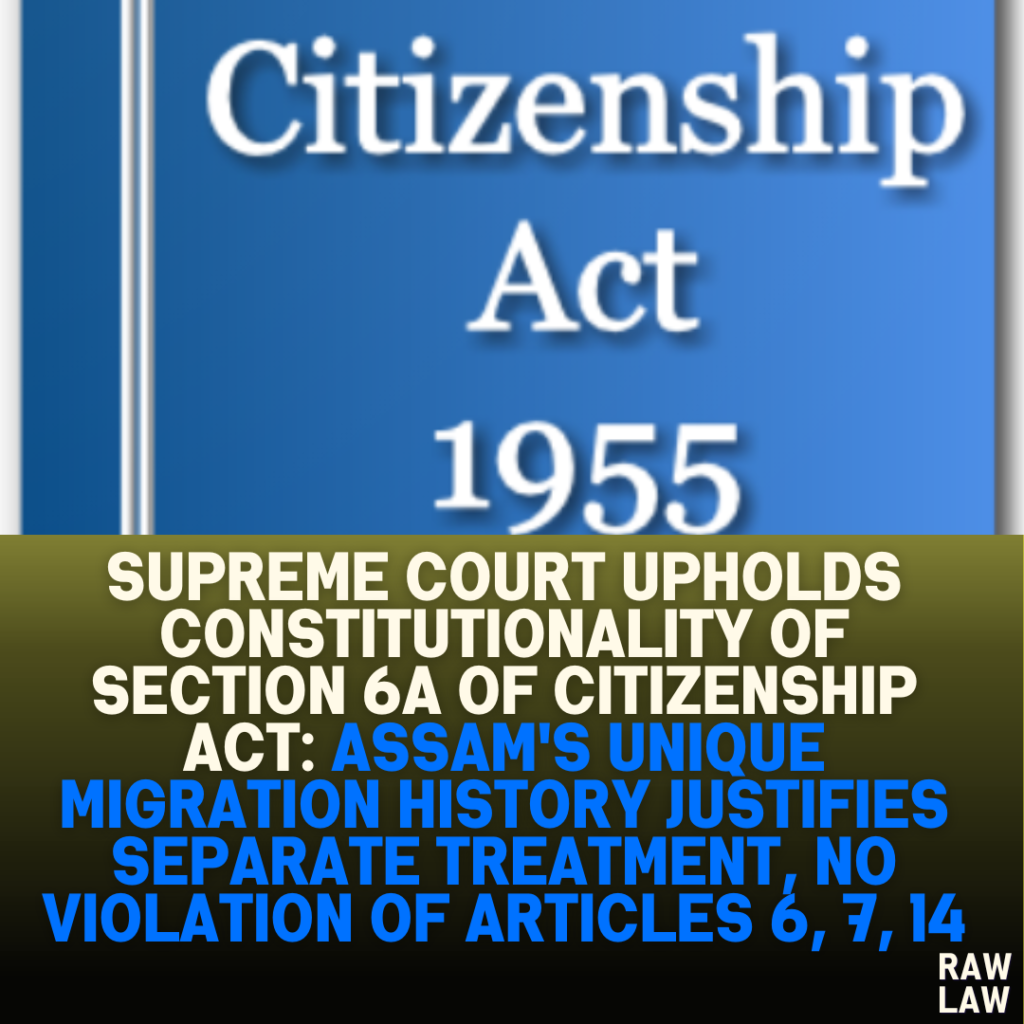Court’s Decision:
The Supreme Court of India, through Chief Justice Dhananjaya Y Chandrachud, upheld the constitutional validity of Section 6A of the Citizenship Act, 1955, dismissing challenges based on Articles 6, 7, and 14 of the Constitution. The court rejected claims that Section 6A prescribes a cut-off date for granting citizenship inconsistent with the Constitution and ruled that Parliament had the competence under Article 11 to legislate on citizenship matters beyond the commencement of the Constitution.
Facts:
The case centered on the constitutional validity of Section 6A of the Citizenship Act, which confers citizenship on certain classes of migrants from Bangladesh to Assam. Section 6A was introduced as a result of the Assam Accord of 1985, aimed at addressing the influx of migrants from Bangladesh. The provision divides migrants into two categories: those who entered Assam before January 1, 1966, and those who entered between January 1, 1966, and March 25, 1971.
The petitioners argued that Section 6A violated Articles 6, 7, 14, and 355 of the Constitution by discriminating against Assam and diluting the political rights of its citizens. They also contended that the influx of migrants had eroded Assam’s cultural identity and that Parliament lacked the legislative competence to enact Section 6A.
Issues:
- Whether Parliament had the legislative competence under Article 11 of the Constitution to enact Section 6A of the Citizenship Act.
- Whether Section 6A violated Articles 6 and 7 by prescribing a cut-off date for citizenship that conflicted with the constitutional provisions.
- Whether Section 6A violated Article 14 by discriminating against Assam and prescribing an arbitrary cut-off date for migrants.
- Whether the influx of migrants into Assam amounted to “external aggression” and violated Article 355.
Petitioner’s Arguments:
The petitioners argued that:
- Parliament lacked the authority to enact Section 6A as Articles 6 and 7 of the Constitution already governed the grant of citizenship to migrants from Pakistan. Any amendment to the constitutional framework for citizenship should have been made through a constitutional amendment, not a parliamentary law.
- Section 6A violated the equality clause under Article 14 by singling out Assam for different treatment, creating a distinction that had no rational basis.
- The provision diluted the political rights of Assam’s citizens and undermined their cultural identity by regularizing migrants from Bangladesh.
Respondent’s Arguments:
The respondents, representing the Union of India, contended that:
- Section 6A was a valid exercise of Parliament’s legislative power under Article 11 of the Constitution, which allows Parliament to make laws relating to citizenship.
- Section 6A did not conflict with Articles 6 and 7 as those provisions governed citizenship only at the commencement of the Constitution, while Section 6A dealt with migrants who arrived after that period.
- The cut-off dates in Section 6A were reasonable and linked to the Assam Accord, a political agreement meant to address the influx of migrants.
Analysis of the Law:
The court delved into the legislative competence of Parliament under Article 11 and the interplay between Articles 6, 7, and Section 6A. It found that the Constitution’s provisions on citizenship applied only at the commencement of the Constitution, while Section 6A governed citizenship for a class of migrants who arrived after the Constitution’s adoption.
The court further held that the classification of Assam for separate treatment under Section 6A was based on the unique historical context of migration in the state and did not violate Article 14.
Precedent Analysis:
The court referred to several previous judgments, including Assam Sanmilita Mahasangha v. Union of India (2015), where a two-judge bench had referred the issue to the present Constitution Bench.
Court’s Reasoning:
Chief Justice Chandrachud reasoned that Article 11 explicitly grants Parliament the power to legislate on matters of citizenship post-commencement of the Constitution. Section 6A did not alter or amend Articles 6 and 7, as those articles applied only to the commencement of the Constitution, while Section 6A dealt with citizenship for migrants entering after the cut-off dates prescribed in the Constitution.
The court also found that the provision did not violate Article 14, as Assam’s situation was unique due to the historical migration patterns, justifying separate treatment under the Citizenship Act.
Conclusion:
The Supreme Court upheld the validity of Section 6A, finding it constitutional and within the legislative competence of Parliament. It dismissed the challenges under Articles 6, 7, 14, and 355.
Implications:
The decision confirms the legality of the Assam Accord’s framework for granting citizenship to migrants from Bangladesh. It underscores Parliament’s power to legislate on citizenship matters, even when they address specific regional concerns, as long as there is a rational basis for the classification.




Pingback: Supreme Court Strikes Down "Decent Behavior" Condition in Remission as Vague and Unconstitutional, Clarifies Re-Arrest Conditions Must Follow Natural Justice Principles to Prevent Arbitrariness Under Article 14 - Raw Law